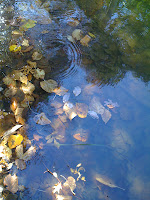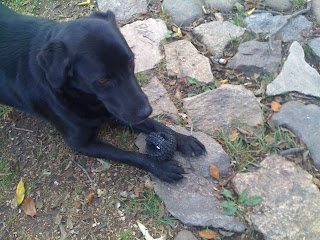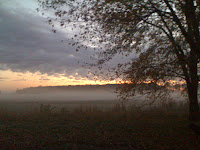 |
| GAMBOLING GOATS |
"Well, of course it's full of ghosts," she said. "It is Halloween."
 |
| WHAT KIND OF FACE DOES IT WANT? |
"No, goats!" I shouted. "They are gamboling amongst the stones."
"Gambling ghosts? Cards or dice?"
"Goats!” I shouted. “The kind that eat tin cans.” I said this, although I know full well that goats don’t eat tin cans. They may nibble on the paper around the tin cans, but not the metal, itself. "Can you call the neighbors and tell them they got through the fence?"
"Goats!” I shouted. “The kind that eat tin cans.” I said this, although I know full well that goats don’t eat tin cans. They may nibble on the paper around the tin cans, but not the metal, itself. "Can you call the neighbors and tell them they got through the fence?"
Well, we finally got it sorted out and I went on to work, but not before calling Michael. He must have been in the shower and didn’t answer his phone, so I left a detailed message asking him to take pictures for me. When he got to work he texted me. "No goats." They must have found their way home by the time he went by.
"That's no costume!" I said, “It’s a disguise.”
"Yes," said Ellis. We're going as secret agents, and secret agents need a disguise." With those words, I knew it was the end of an era. No longer are my services required as maker of masks or of totally awesome swords and shields. No longer are my seamstress skills necessary. I’ll just put my sewing machine away up in the attic. No more capes or hoods or swashbuckling pantaloons.
"Yes," said Ellis. We're going as secret agents, and secret agents need a disguise." With those words, I knew it was the end of an era. No longer are my services required as maker of masks or of totally awesome swords and shields. No longer are my seamstress skills necessary. I’ll just put my sewing machine away up in the attic. No more capes or hoods or swashbuckling pantaloons.
I might have argued that since No-shave November was almost upon us, a mustache was not much of a disguise, either, but they also dyed their hair. Since it was probably the last year that they can get away with knocking on doors and demanding candy, I relented, and stayed home to comfort myself with pumpkin carving.
 |
| Treat in Beauty; Trick in Peace; Blessed Be. |
The Pumpkin was big and round, but a little flat on one side. It spent the past several weeks silently greeting everyone who came in the kitchen door. It was a little flat on one side and that side still had a little mud caked on it, although it had kept its silent vigil through at least two rainstorms. I wiped it clean and patted its cheek, peering at it to see what kind of face it wanted. It didn’t want to be a zombie, so popular now, with stringy, orange “brains” spilling out of its mouth. I cut its cap and scooped out the seeds, putting them into a bowl to roast later. No, it just wanted a couple of triangular eyes and a lopsided, jagged smile. I found a candle and set it back outside to greet the trick or treaters. The yellow light shone bravely into the dark night.





























































